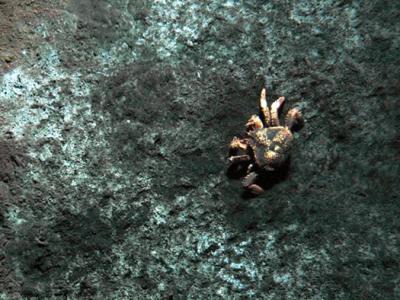Opinion: Florida’s Great Snake Hunt Is a Cheap Stunt
Bill Booth wears a dead Burmese python he caught in Florida as part of the monthlong Python Challenge.
Editor's note: Bryan Christy is a contributing writer for National Geographic and author of The Lizard King: The True Crimes and Passions of the World's Greatest Reptile Smugglers.
The kickoff event for Python Challenge 2013, Florida's monthlong snake-killing tournament, was catered. "We've got snakehead fish tacos," chef David Pantone tells me, pinching his fingers into the okay sign chefs use to signal perfection.
"It's an amazing, smooth white fish. It's my new favorite fish in the world," Pantone says of the invasive species native to China. Pantone, who is dean of Lincoln Culinary Institute of West Palm Beach, Florida, stands behind a foldout table set up beside the Python Challenge 2013 registration desk. He wears a white chef's hat and coat, as do his assistants working a makeshift kitchen behind him.
"We've got caiman, which is like a big alligator. We turned it into a white bean chili. We harvested its tenderloins in the best parts of its tail," he says, moving his hands along an imaginary reptile's flank. He also has green iguana that he turned into an old-fashioned, Italian-style stew.
Pantone says all of the animals on his menu came from Florida's Fish and Wildlife Conservation Commission (FWCC), whose idea it was to launch Python Challenge 2013, which awards $1,500 dollars to the person who brings in the most dead Burmese pythons by February 10, with another $1,000 for the biggest python.
It's useful to turn wildlife problems into something else, such as a meal. After decades of importing hundreds of thousands of Southeast Asian pythons—Burmese and others—to supply the American pet trade, Florida discovered its Jurassic Park reptile wholesale industry had a flaw: Snakes get out.
So do iguanas, macaws, lionfish, monkeys, and myriad other exotic species that Florida's wildlife dealers import or breed, Americans keep as pets, and Florida now hosts as established species.
Rules of the Game
It's also helpful in an event as violent and ill thought out as this one to distract the public from a key detail: Python Challenge contestants are forbidden to bring any snakes they find in alive.
Instead they're advised to brain the pythons with a captive bolt gun (the weapon used by the villain in No Country for Old Men), chop their heads off, or shoot them. No experience is required. Training can be done online by reviewing slides showing pictures of pythons and other non-native snakes along with pictures of Florida snakes. Kill these, don't kill those.
I took the training course and finished in under two minutes. There was no test at the end. I was surprised that even though I've caught snakes my whole life and have held many Burmese pythons, when shown side by side they look very much like Florida's native snakes, including red rat snakes, water snakes, and the eastern diamondback rattlesnake.
Python Challenge 2013 is high tech, with a website and a smartphone app called IveGot1. Awards will be made February 16 at Zoo Miami.
For decades Florida created tourist traps around its reptiles, named sports teams for them, and profited from trade in them as pets. Florida is home to the eastern indigo snake, a python-size animal whose gentleness made it so highly desired as a pet that it is now threatened and federally protected. The secretive—and protected—gopher tortoise also calls Florida home.
The state has long celebrated its reptiles, but now it has loosed an activity that tells a new generation of children that the only good snake is a dead one.
I registered as a python hunter but I did not really intend to hunt pythons. I wanted to see my first wildlife rumble, a fight between snake haters and animal rights activists, something along the lines of those protesters who dress up as wolves or polar bears, or who splash fake blood onto Canadian politicians to protest clubbing seal babies.
Instead I discovered something resembling a scene in the film Jaws—not the one where the town hires a seasoned shark expert to go out and kill the great white, but the ridiculous scene where every idiot with a pitchfork and an inner tube is paddling out to get a piece of shark meat.
I met contestants who had never seen a Burmese python before, who had never handled a snake. I overheard one man telling some greenhorns from Maine that his technique is to swing a snake by the tail and slam its head into a tree. "It stuns 'em," he said.
Friendless Snakes
No one protested the launch. People for the Ethical Treatment of Animals sent a letter to the FWCC opposing decapitation, arguing that even though the technique is deemed conditionally acceptable by the American Veterinary Medical Association, it "cannot be performed in a humane manner in the field [italics theirs]."
The Nature Conservancy showed up, but they're a partner in the Python Challenge, a contrast to their own python control program, and provided the training materials.
In the grass outside the registration building, Miami-Dade Fire Department snake expert Jeff Fobb, a volunteer with The Nature Conservancy, demonstrated the proper way to capture a python. This isn't the method they're telling you to use, he said of the FWCC making his exhibition superfluous even as cameras from major news networks filmed him in action.
Fobb prefers pythons be brought in alive for experts to dispatch, but the FWCC insists upon its brutal methods and even sent me an email on day two of the event reemphasizing that no snakes be brought in alive.
We euthanize unwanted dogs and cats, and we put people in prison for cruelty to them. But we vilify these escaped pythons, and we pretend cruelty is the price we pay to protect an ecosystem.
A Burmese python reportedly ate an endangered Key Largo woodrat a few years ago, and certainly the snakes must eat something—but there is significant debate about whether Burmese pythons warrant the witch hunt they've inspired.
No one believes Burmese pythons in Florida can be eradicated. The pythons are here to stay. They are part of Florida now. How we treat these animals at our periphery says a lot about how we will treat life more dear to us.
And exotic is relative. According to the American Bird Conservancy, pet and feral housecats kill hundreds of millions of birds and more than a billion rabbits, squirrels, chipmunks, and other small mammals each year. But Florida does not have a website with an X in the middle of a Siamese cat's head, as it does for the Burmese python, showing where to hit it with a hammer.
"They're the poster child for invasive species," Frank Mazzotti, professor of wildlife ecology for the University of Florida (Go Gators!) and the lead scientist for the Python Challenge, says of Burmese pythons.
"If this were a piranha derby, we'd get this attention," he says, taking in the massed TV cameras, but not if it were, say, the Cuban tree frog, which he notes has a greater environmental impact. "It sounds cynical," he says, "but it's true."
As of this morning over 1,100 people have registered for Python Challenge 2013, and have located and killed 27 Burmese pythons. It is a poor return on an investment in amateurs.
Bryan Christy
for National Geographic News
Published January 22, 2013












